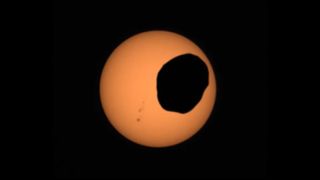A long-lost moon could explain Mars’ strange shape and extreme terrain

A long-lost moon may explain why Mars is so different from the other rocky planets in the solar system.
Today, Mars it has two small months. But early in its history, the Red Planet may have had a larger moon, which could be responsible for Mars’ strange shape and surface, Michael Efroimsky, an astronomer at the US Naval Observatory in Washington, DC, suggests in paper that has been submitted to the Journal of Geophysical Research: Planetary and is available as a preprint via arXiv.
Mars is home to some of the most extreme areas in the solar system, including the largest canyon, tallest mountain and largest plateau. This highland region, known as the Tharsis plateau or Tharsis plateau, dominates the western hemisphere of Mars near its equator. The Tharsis region is 3,100 miles (5,000 km) wide and rises to 4.4 7 miles (km) high, not including its large shield craters, which rise even higher. Almost on the other side of the planet from Tharsis are Terra Sabaea and Syrtis Major, another highland region and a large shield volcano, respectively.
Either way, Nerio’s critical mass changed the shape of Mars and its own attractionraising tides in the magma ocean in the same way Earth month raises waves in the oceans of our planet today. But because Mars is smaller than Earth, it cooled more quickly and its water waves locked into the planet’s shape.
Somehow, Nerio got lost, Efroimsky wrote. It could have been obliterated by the collision, leaving behind Mars’ current moons, Phobos and Deimos, he suggested, or it could have been scattered out of the solar system through a gravitational interaction with another body.
Such collisions and scattering were common in the early solar system. Astronomers think The world acquired its moon through a collision with a Mars-sized protoplanet and the scattering between the outer planets shifted their original orbits, which were previously closer to the sun, into their current positions.
But as long as Nerio stayed around long enough to destroy Mars as it cooled, it could have kept the planet’s mysterious atmosphere, Efroimsky said. Further geological processes could have continued the work, uplifting the highlands and causing the irregular shape of Mars.
Related: NASA’s Curiosity rover accidentally uncovers rare sulfur crystals after crushing a rock on Mars.

While the possibility is intriguing, Efroimsky admitted that Nerio’s explanation is only hypothetical. The idea of a large moon held briefly raises many questions, especially about its formation and disappearance. For example, if Nerio was destroyed, it should have left a series of craters along the belt corresponding to its circumference, but there is no such crater belt. On the other hand, further collisions and geological activity could erase those effects.
Furthermore, the hypothesis requires geological processes to take the thrusts and faults created by Nerio into their modern state, by uplifting the highlands. While it is reasonable to assume that heating and cooling processes in the interior of Mars would naturally exacerbate any distortions in the planet’s shape, it is not guaranteed.
Efroimsky has called on other researchers to evaluate the idea and consider whether there are reasonable ways to find evidence of this lost moon.
Join our Space Forums to keep talking about the latest missions, the night sky and more! And if you have a tip, correction or comment, let us know at: [email protected].
Originally published Space.com.
#longlost #moon #explain #Mars #strange #shape #extreme #terrain



